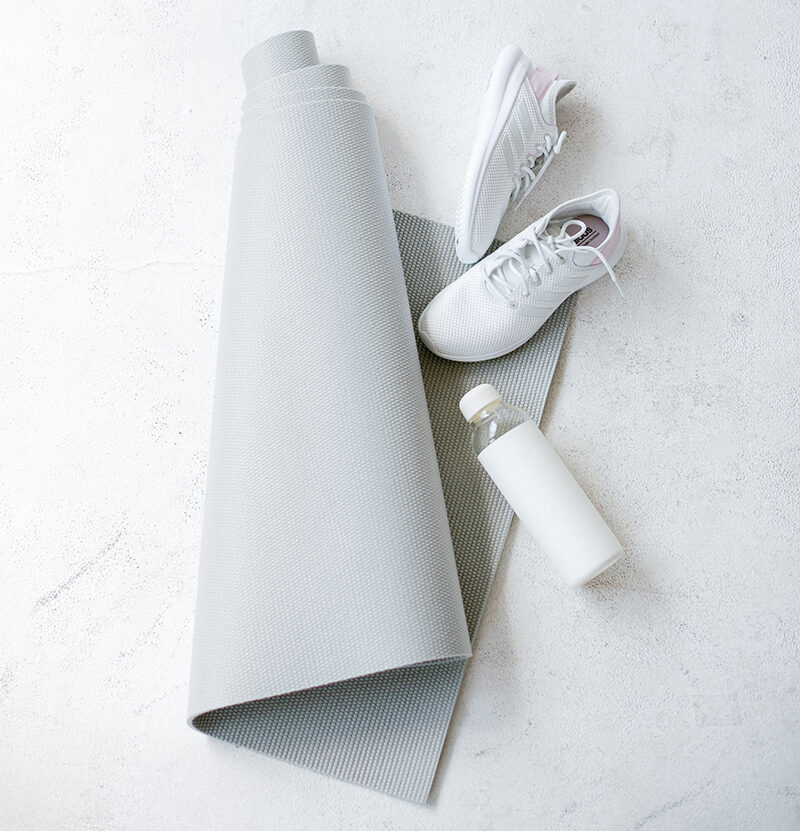So many women don’t recognize the power in how their period affects their workout and how to maximize their cycle to their advantage. The female body is so incredible. The more I study the role of the body in terms of both functional health and athletic performance, the more amazed I am at what women can do.
To answer the big question of “how does my period affect working out?” we first need to start with an understanding of what hormones play what role in the body. And then we can dive into how to use that to our advantage when it comes to both fitness and nutrition to maximize training and athletic performance.
The big takeaway = your period is not a hindrance to your fitness goals! In fact, it is your superpower to achieving them!
How Your Period Affects Your Workout: The Role of Hormones
Hormone health plays a crucial role in athletic performance for women, as hormones are responsible for regulating various physiological processes that impact energy levels, muscle function, metabolism, and overall physical performance. Some of the key hormones that influence athletic performance in women include estrogen, progesterone, testosterone, cortisol, and thyroid hormones.
Estrogen and Progesterone: These are the primary female sex hormones that fluctuate throughout the menstrual cycle. During the follicular phase (before ovulation), estrogen levels rise, which can enhance the use of carbohydrates for energy, potentially improving endurance performance. During the luteal phase (after ovulation), both estrogen and progesterone levels increase, which might affect body temperature and fluid balance. Some female athletes report increased injury risk and reduced performance during the luteal phase due to these hormonal changes.
Testosterone: Although testosterone is considered a male hormone, it also exists in smaller amounts in women. Testosterone plays a role in muscle growth, strength, and bone density, all of which are essential for athletic performance. Women with higher testosterone levels might have a slight advantage in certain sports that require strength and power.
Cortisol: Cortisol is a stress hormone that increases during intense exercise and other stressful situations. While it helps mobilize energy reserves for physical activity, chronically elevated cortisol levels can lead to muscle breakdown and hinder recovery.
Thyroid hormones (T3 and T4): Thyroid hormones regulate metabolism, affecting energy production and utilization. An imbalance in thyroid hormones can lead to fatigue, weight fluctuations, and reduced athletic performance.
How Your Period Affects Your Workout: Hormones & Athletic Performance
Athletic performance can be influenced by the interplay of these hormones and how they respond to factors like training load, stress, nutrition, and sleep. Here are some considerations for optimizing hormone health and athletic performance in women:
- Menstrual cycle tracking: Understanding how hormone fluctuations affect energy levels and performance can help female athletes plan their training and competition schedules more effectively.
- Nutrition: Proper nutrition is essential for hormone health and athletic performance. Sufficient intake of macronutrients (carbohydrates, proteins, and fats) and micronutrients (vitamins and minerals) is crucial for supporting hormone synthesis and overall health.
- Sleep and recovery: Restful sleep is essential for hormone balance and recovery. Prioritize adequate sleep to optimize performance and reduce the risk of hormonal imbalances.
- Training load and intensity: Overtraining or excessive exercise can lead to hormonal disruptions and negatively impact performance. Finding the right balance between training intensity and recovery is key.
- Stress management: Chronic stress can lead to imbalances in cortisol and other hormones. Implement stress-reduction techniques such as meditation, breathwork, yoga, or other relaxation methods.
- Medical evaluation: If you suspect a hormonal imbalance or notice unexplained changes in performance or well-being, consult a healthcare professional. DUTCH testing can provide insight to how hormones are being metabolized in the body and can help target interventions to improve athletic performance.
Since each of us are unique, individual differences in hormone profiles can influence athletic performance differently. Listening to your body, tracking your menstrual cycle, and seeking professional guidance can be beneficial for optimizing hormone health and maximizing athletic performance.
How Your Period Affects Your Workout: The Menstrual Cycle
The menstrual cycle can have various effects on a woman’s body, including how it impacts her ability to work out and perform during exercise. The menstrual cycle consists of two main phases: the follicular phase and the luteal phase. These phases are controlled by fluctuations in estrogen and progesterone levels, which can influence energy levels, metabolism, and physical performance. Here’s how each phase connects to fitness pursuits:
Follicular Phase (7-21 days): This phase starts at the end of menstruation and lasts until ovulation. During this phase, estrogen levels gradually rise. Some potential effects on workouts during the follicular phase include:
- Increased Endurance: Higher estrogen levels may enhance the use of carbohydrates for energy, potentially improving endurance performance.
- Better Recovery: Estrogen can have anti-inflammatory effects, which might aid in recovery from intense workouts.
- Reduced Risk of Injury: The increased levels of estrogen may be associated with improved collagen synthesis, which can help maintain joint and tissue integrity, reducing the risk of injury.
- Take Action: the brain is focused on getting things done, and there is the energy to support it, so now is the time to try new things, push workouts a little harder, focus on intensity, speed, and strength.
Ovulation (lasts 1 day): Ovulation occurs roughly in the middle of the menstrual cycle. During this time, estrogen levels peak, and there is a brief surge in luteinizing hormone (LH), which triggers the release of the egg. Some women may experience a temporary increase in energy and mood during ovulation, which can positively influence workouts.
- Prime energy: Since this is when hormones rise and peak, this is the time you have the most energy and can get out there and chase that PR.
- Feeling tired? If you find you don’t have energy right now, you may want to check your progesterone levels. Progesterone peaks after ovulation, but if it is chronically low month to month, you may feel worse right now and be more lethargic.
Luteal Phase (10-16 days): This phase begins after ovulation and lasts until the start of the next menstrual period. During this phase, both estrogen and progesterone levels rise and then decline if pregnancy does not occur. Some potential effects on workouts during the luteal phase include:
- Increased Fatigue: Progesterone, especially in its later stages, may contribute to feelings of fatigue and decreased motivation for exercise.
- Reduced Performance: Some women report decreased exercise performance during the luteal phase, likely due to hormonal fluctuations affecting energy levels and fluid balance.
- Increased Injury Risk: Hormonal changes might affect joint laxity, potentially increasing the risk of injury.
- Slow down: This is the time to focus on steady state activity, build endurance, and prioritize mobility, cross training, and breathwork/mindfulness practices
- Racing considerations: if you have a race now, do not worry! You can still reach that PR, but know you may need to support your training and racing with extra fluids and carbohydrates to counteract the decreased carbohydrate oxidation and increased metabolic effects of progesterone.
Menstrual Phase (3-7 days): This is the bleeding phase. During this phase, hormone levels drop and the body releases the uterine lining. It is a time for cleansing, deep release, and introspection. Potential implications on fitness include:
- Boost in immunity: Recovery from activity is high, endorphins are high, so pain tolerance is also high. We can do more and recover well. Contrary to popular belief, this is a great time for high performance!
- Higher stress resiliency: Since the body is more resilient to stress now, this is the time to push the intensity, if you feel up to it. If you aren’t, this is also a great time for rest, recovery, and reflection.
- Higher carb tolerance: The body can more easily convert carbohydrates to energy now, which makes it a great time to push for higher intensity workouts if desired.
- Planning ahead: The left and right brain are most interconnected now, so it is a great time to make decisions. This is the time most clearly reflect on the past training cycle, make note of changes you wish to make, and prepare for future training.
It’s important to note that the effects of the menstrual cycle on workouts can vary widely among individual women. Some may experience minimal changes in exercise performance, while others may notice more significant fluctuations. Additionally, factors such as training status, overall health, stress levels, and nutrition can also influence how the menstrual cycle affects workouts.
To optimize workouts throughout the menstrual cycle, some women may choose to adjust their training intensity, volume, or types of exercises based on how they feel during different phases. Keeping a workout journal or using apps that track the menstrual cycle and workout performance can help identify patterns and plan workouts accordingly. Additionally, maintaining a balanced diet, staying hydrated, getting adequate rest, and managing stress can all contribute to better exercise performance regardless of the menstrual phase.


